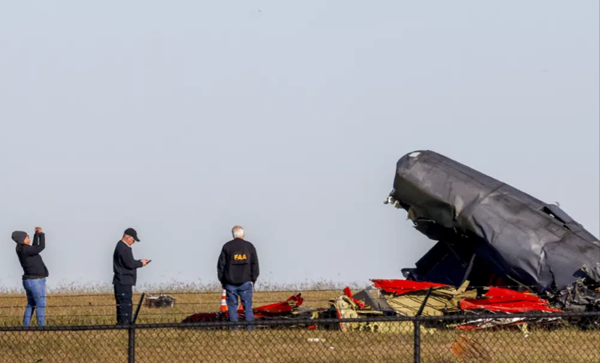Just before a midair collision that killed six at a Dallas air show, a group of historic fighter planes was told to fly ahead of a formation of bombers without any prior plan for coordinating altitude, according to a federal report released Wednesday. The report did not give a cause of the crash.
A P-63 Kingcobra fighter was banking left when it struck a B-17 Flying Fortress bomber behind the left wing during the Nov. 12 air show featuring World War II-era planes, the National Transportation Safety Board said in its preliminary findings. All six people aboard the planes — the pilot of the fighter and the bomber’s pilot, co-pilot and three crew members — died as both aircraft broke apart in flight, with the bomber catching fire and then exploding on impact.
There had been no coordination of altitudes in briefings before the flight or while the planes were in the air, the NTSB said. The report said that the Kingcobra was the third in a formation of three fighters and the B-17 was the lead of a five-ship bomber formation.
John Cox, a former airline captain with more than 50 years’ experience, was surprised that the NTSB found there wasn’t an altitude deconfliction brief before or during the flight. He said these take place in other air shows, but he’s not certain whether they’re standard for the Commemorative Air Force, which put on the Wings over Dallas show.
A person familiar with the show’s operations that day said the air crews were given general altitude direction in their morning pre-show briefing. However, there was not a discussion of specific altitudes for each pass the aircraft were going to perform, said the person, who was not authorized to discuss the matter publicly and did so on condition of anonymity.
Typically fighters fly above bombers, and when a group is called to make a pass that could put planes at the same or nearly the same altitudes, they maintain a lateral separation from each other, the person said. In general, the person continued, it’s the responsibility of the air boss to set out a plan for maintaining either vertical or lateral separation.
The NTSB said the fighter formation had been told by the air boss to proceed to a line that was 500 feet from where the audience was lined up at Dallas Executive Airport, while the bomber formation was told to fly 1,000 feet from the audience viewing area.
The NTSB said a navigation device on the bomber “contained position information relevant to the accident” but a device on the fighter didn’t record during the flight.
Officials, including those from the Federal Aviation Administration, survey damage from Saturday's crash of a Boeing B-17 Flying Fortress and a Bell P-63 Kingcobra at Dallas Executive Airport on Sunday, Nov. 13, 2022, in Dallas. (Liesbeth Powers/The Dallas Morning News via AP)
Advertisement
FAA releases report on Dallas air show crash
Advertisement
Latest State & National
State & National
2 hours ago
State & National
3 hours ago
State & National
yesterday
State & National
yesterday
State & National
yesterday
ADVERTISEMENT
Most Read >
ADVERTISEMENT
Latest State & National
State & National
2 hours ago
State & National
3 hours ago
State & National
yesterday
State & National
yesterday
State & National
yesterday
Advertisement
ADVERTISEMENT



.png?lang=en-US&width=600&height=411&ext=.png)

